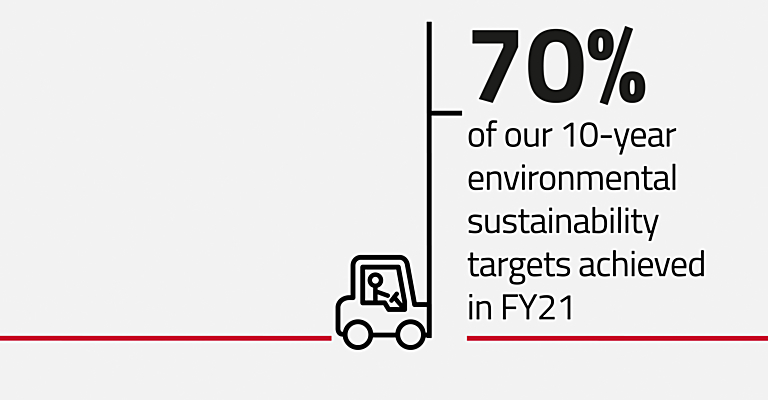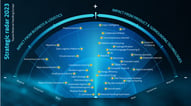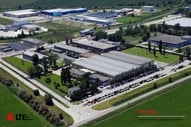Today, more and more companies are working to put sustainability at the heart of their corporate culture. At Toyota Material Handling Europe, when we talk about a sustainable culture, we mean it in a specific sense. In the first instance, we inherit our culture from Toyota in Japan, where respect for nature is embedded deep in tradition. Japan is an island with relatively few natural resources – and on top of this, Toyota was founded during a time of scarcity. Minimising waste has always been part of our philosophy.
Over time, this focus on efficiency grew into a wider commitment: that as a company, we should never be a burden on nature. We believe that economic and ecological success go hand in hand: that delivering sustainable, future-proofed systems is a core part of the value we offer customers.
Toyota Material Handling Europe has been on a sustainability journey since 2013, when we published our first sustainability report in line with the standards of the Global Reporting Initiative, setting out our target to reduce CO2 emissions by 30% by 2021. Every year since then, we have learned from our experiences, assessing what has worked and what needs to be improved to take our efforts to the next level and achieve our vision of a net zero economy.
How far have we come in 2021?
The previous year has been one of disruption, and of rethinking how every aspect of the traditional supply chain works. It was our aim – and more than that, our duty – to bring about a resilient, climate-smart recovery. Now, our journey has reached an important milestone.
As of April 2021, we have managed to meet 70% of the sustainability targets that we had set back in 2012. We have also been able to reduce emissions from our own factories, offices, service vans and company cars by 29% since we took a baseline figure in 2012, less than a decade ago. In the same period, we grew revenues by over 50%, demonstrating that commercial success and emissions don’t have to be tied together. This puts us in a credible position to support our customers and encourage our suppliers to also deliver significant cuts in emissions.
Making a large contribution to this overall figure is our facility in Mjölby, Sweden, which is completely emissions-free within its own operations. Powered by renewable electricity, district heating and liquid biogas, it is the first of our facilities to go zero-carbon in terms of both on-site activities and the energy it sources from suppliers. This isn’t just a technological breakthrough but a cultural one: all employees bought in to Mjölby’s sustainability drive and showed a clear belief in its potential for real change. The team at Mjölby are now turning their attention to addressing supply chain emissions, helping customers and suppliers master the adoption of renewable energy sources.

I am also pleased to report that we now source 100% of our electricity renewably, across all our operations and locations: five factories, 21 national sales companies, our head office locations in Mjölby, Göteborg and Willebroek, and several warehouses across Europe. We first expressed this as a goal in 2018 – so it is heartening to achieve a concrete result just three years on. So often, sustainability is expressed in terms of targets for the next decade, and while these are important, it’s equally important that we take environmental action now. In our case, this switch contributes 15% of the necessary CO₂ reductions we need to reach net zero.
Recognition for sustainable results
Action is one element of our sustainable culture. Another is transparency. We work with internationally recognised agencies to ensure our progress is tracked, monitored and approved against commonly accepted standards and goals.
We work closely with EcoVadis, the business sustainability barometer that considers a wide range of factors: environmental impact, respect for employees, ethics, and sustainable procurement. This adds the transparency and accountability that many customers demand, allowing our sustainable credentials to pass more easily along the value chain.
In 2021, EcoVadis awarded us a platinum rating, putting us among the top 1% of the companies assessed in our sector. Not only was our overall organisation assessed, but each of our factories and sales companies went through the same process at individual level. As a result of these assessments, we have become the first ever company with over 50% of its local entities achieving EcoVadis Gold or Platinum. It’s a sign that sustainability is truly embedded in our organisation.

At the same time, our parent company, Toyota Industries Corporation (TICO), received two ‘A’ ratings from CDP, in its Climate Change and Water Security categories. TICO’s submission to CDP included European operations, so the score reflects our commitment and priorities in our European organisation. In our view, it’s not enough just to be aware of climate impacts, or to make efforts in order to tick a regulatory box. Our goal is to be leaders in sustainability, setting the agenda with our technologies, initiatives and results.
The most recent development on our certification journey is our Mjölby factory receiving ISO50001 accreditation in April 2021. This was achieved after a rigorous analysis of how the plant uses energy and how further savings could be made, starting with those that will achieve the most impact. We intend to take this further and put all our factories through the ISO50001 procedure in the coming years.
The journey is never over
What does our 29% emissions reduction tell us? It tells us that, though we have made good progress, our journey is far from over. Going fully zero-carbon means doing more. It means rolling out technologies like the ones seen at Mjölby more widely, and it also means designing and testing new, innovative processes that can take our efficiency to a new level. For example, we are currently investigating the possibility of switching to renewable gas for all our European operations.
Here is where we revisit our Japanese parent company, and the values we have grown to share. In Europe, when setting targets, it’s common to stick to what we know is achievable – say, a 5% improvement on what we managed last year. In Japan, that target is more likely to be a 50% improvement – a far greater challenge. But ultimately, you are hardly judged by whether you meet that target: it’s designed to inspire progress, ambition, and creative thought. You are judged by your ongoing efforts over your final results.
We’ve adopted the Japanese culture of kaizen: continuous improvement. Under this principle, the important thing is to get started, even if you haven’t worked out every step you’ll take between your current position and your destination. Our approach to sustainability puts kaizen at its heart. We can’t just do what we think is achievable right now – we think much bigger, and every day we try to do something that turns that thought into reality.
What this means for our customers
Where will this journey take us next? Our long-term focus is on making our sustainable principles available not just to us, but to our customers too. We are quite far ‘upstream’ in the supply chain, and as much as 90% of our associated emissions occur ‘downstream’ in the form of our customers using our products.
Our efforts to reduce these emissions fall under two categories: technology and co-operation. As for the former, we have managed to electrify 90% of our truck fleet, and counting. Our Stage 5 motor has no particulate emissions. We are growing the scope and availability of our fuel cell offering, which has the potential to be completely emissions-free when renewably sourced hydrogen is used.
When it comes to co-operation, we see ourselves as a trusted partner for both our suppliers and customers, aligning their sustainability journey with ours. We have trained thousands of drivers, allowing them to use vehicles more efficiently and consume less power. And we meet with our own suppliers every year, jointly coming up with new ideas to lessen our environmental impact.
If sustainability is a journey, then we will accelerate fastest along that journey when we work together, sharing insights and innovations. After all, no single entity can redesign a whole supply chain – but together, we have that power. Whether you have high targets or are only at the beginning of your sustainability journey, I’m sure there is a way we can support each other. Read the latest on our journey or get in touch.





